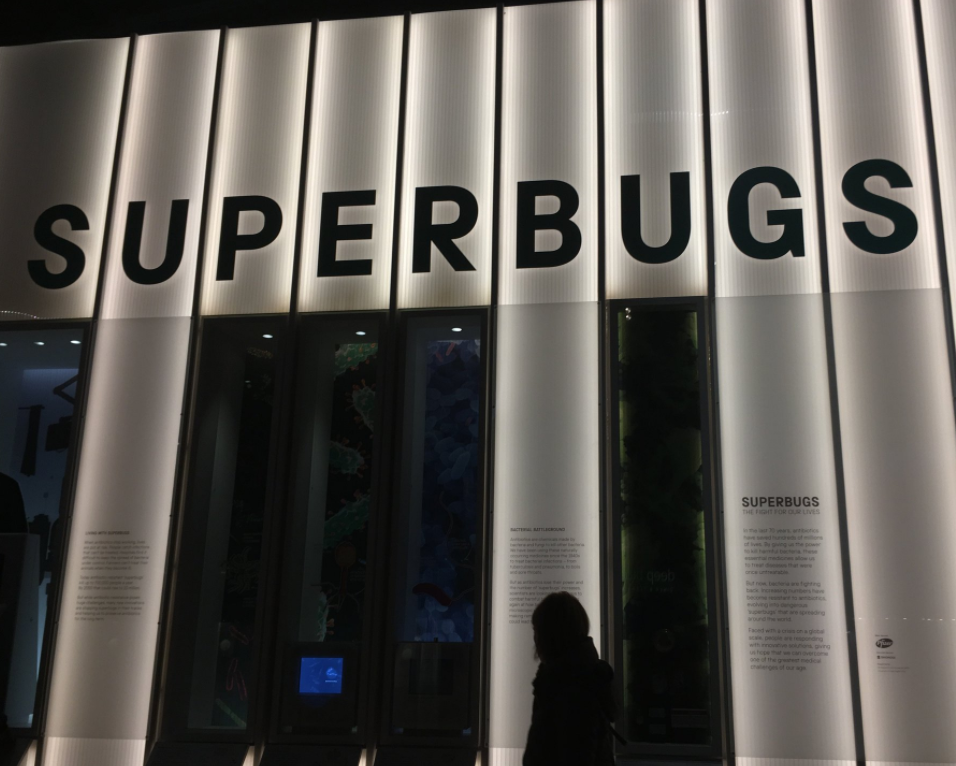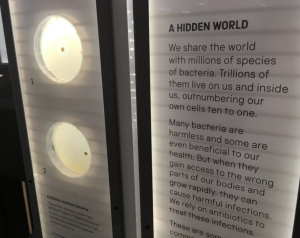
March 27, 2018, by cmay
‘Superbugs: The Fight For Our Lives’ Exhibition Review
By Viviane Mignone, Postdoctoral Fellow
The indiscriminate use of antibiotics over the last century has created a global threat that is responsible for approximately 700,000 deaths a year, worldwide. The current projections state that by 2050, 30 million people may die from a superbug infection. The attempts to stop this exponential rise of superbugs involves not only scientists, but also food and farming industries, as well as the general public.
The Superbugs: The Fight For Our Lives exhibition, which is taking place at the Science Museum until Spring 2019, brings to the audience this global health issue that is not specifically related to any risk group, which makes it really close to everyone. And that is the main approach of the exhibition: bringing together the stories of real people, making it easier for the public to relate to the problem. In a guided tour with the curator of the exhibition, Sheldon Paquin, researchers and postgraduate students could not only experience it as the general public does, but also have an insider view of what it takes to create such an exhibition. One year of research, visits to labs, and lots of interviews with researchers, patients, health professionals, industry, and government workers were undertaken to gather enough data to have a good story to tell.
Usually, the first thought that comes to mind when people hear the word “bacteria” is that it is equal to harmful. This is the main idea spread across the common media, so the first part of the exhibition shows that bacteria are our longest friends on earth, living inside us since the very beginning and actually protecting us. It is done in an interactive way where people can explore the microscopic world of bacteria through visual displays. Then the viewer is presented with real characters sharing their stories: from a survivor of a superbug infection to hospital staff showing how they try to minimize the risks of superbug infections. It also shows how patients are not aware of the risks of taking antibiotics unnecessarily and, that by doing that, they contribute to the rise of new superbugs.

An example of an exhibition panel, entitled ‘A Hidden World’
The exhibition also has an interactive demonstration of how technology is helping the food industry to minimize the use of antibiotics in animal husbandry. Robots can identify sick animals and rapidly separate them from healthy ones, avoiding contamination and the need for antibiotics. The final part of the exhibition explores the attempts of discovering new sources of antibiotics to combat superbugs. To encourage this much needed research, the UK Government and Nesta (a charity which promotes innovation) will award the £10 million Longitude Prize to the first research group to develop a fast, affordable and accurate diagnostic kit for bacterial infections. It highlights how the authorities are struggling to prevent new superbug infections and are racing to find new solutions to control the current ones.
After going through the exhibition, the general public is made aware that we are all part of the problem and that we can also be part of the solution. One does not need to be a scientist for that: as a patient, everyone can avoid self-medication and responsibly use antibiotics.
This visit was generously funded by the University’s Faculty of Medicine and Health Sciences and the Medicine and Health Sciences Graduate Centre. The exhibition is running at the Science Museum, London, until Spring 2019, and includes contributions from Professor Liz Sockett.

Nice article Viviane. I loved the exhibition, it did make me start considering science communication and public engagement. I was very impressed by the account of how much research went into creating the story and exhibition.